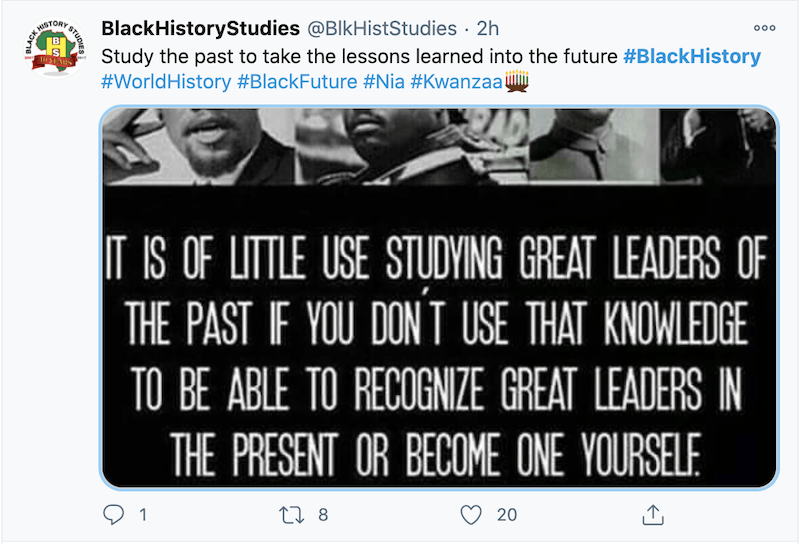PPC
47 Creative February Marketing Ideas (Beyond Valentine’s Day!)

February is home to the most romantic holiday of the year:
Just kidding (shouldn’t that be in March anyway?). But there is so much more to February than Branch’s Conversation Hearts and #sharethelove. So today, I’m showering you with over 50 creative and February marketing ideas and examples to help you connect with customers and build your brand.
Table of contents
February awareness causes
Below is a list of awareness causes recognized in February that can help you with cause-related marketing.
- American History Month
- American Heart Month (heart disease)
- Bake for Family Fun Month
- Black History Month
- Cancer Prevention Month
- Children’s Dental Health Month
- Embroidery Month
- Free and Open-Source Software Month
- Library Lover’s Month
- Self-Check Month
- Teen Dating Violence Awareness Month
- Wedding Month
Some of these are general while others are highly specific, so depending on your business, your trade, or your niche, you may or may not be able to apply these to your February social media and marketing campaigns (National Embroidery Month isn’t exactly versatile, for example).
February national days
There’s a full list of February national days and dates at the bottom of this post, but here are some highlights:
- Known: Groundhog Day, President’s Day, Valentine’s Day (Valentine’s Day marketing ideas here), Galentine’s Day.
- Fun: Day the Music Died Day, Ice Cream for Breakfast Day, Don’t Cry Over Spilled Milk Day, Make a Friend Day, Do A Grouch a Favor Day, Comfy Day, Optimist Day.
- Meaningful: Freedom Day, Girls and Women in Sports Day, Wear Red Day, Safer Internet Day, Random Acts of Kindness Day, Shut-In Visitation Day, Set a Good Example Day, Skip the Straw Day.
- Industry-specific: Toothache Day, Dog Biscuit Day, Love Your Pet Day, Spay Day, Clean Out Your Computer Day, Caregivers Day, Lash Day, Home Warranty Day, Women Physicians Day.
- Well alright: Public Sleeping Day.
February diversity, equity & inclusion
Alright, now it’s time to get into the marketing ideas. Let’s start with important dates and observances that can help you in your diversity, equity, and inclusion efforts.
- Black History Month: Your Black History-related content should not actually be a marketing ploy but a genuine initiative to raise awareness and promote civil rights.

Here are some things you can do.- Highlight prominent Black leaders in your industry—lawyers, politicians, scientists, artists, educators, and athletes who have shaped or are shaping American society or your industry.
- Interview or feature Black business owners, influencers, or members of your community who are helping to make history.
- Share quotes, little-known facts, and eye-opening stats about Black History—especially those related to your industry or niche.
- Tammy Baldwin’s birthday (Feb 11): Tammy Baldwin is the first openly LGBT woman elected to both houses of Congress. Post an inspiring quote from her on Instagram or Facebook.
- Susan B. Anthony’s birthday (Feb 15): This famous female is a leader of the women’s suffrage movement who advocated for abolition, labor rights, equal pay and more. On this day, share an eye-opening statistic or inspirational quote to raise awareness.
Meaningful February marketing ideas
In addition to inclusivity, there are plenty of other themes during February that can help you with meaningful marketing. Showing your support for causes you care about is a great way to connect with your audience and express your core values. Here are some ideas and examples.
Heart Health Awareness Month
So February isn’t all about that $1 pink balloon heart but also that invaluable organ inside of you that makes you tick. If your business is focused on health and wellness, this is a great marketing opportunity for you.
- Fitness centers and gyms can partner with a local health center for heart disease awareness or screenings.
- Host special classes focusing on cardiovascular activity.
- Write informative blog posts about heart health and risk factors. Use this time to market your business by educating your customers on leading healthy lives.
- Give out a free heart-healthy gift with purchases or registrations.
In the example below, this fitness center is giving out free heart rate monitors to those who join in the month of February.
If you’re not a health or fitness business, no problem.
- Any business can sponsor a Healing Heart 5k, or donate a portion of their profits to a heart health-related nonprofit.
- Think outside the box—pet hearts, artichoke hearts, hearts of remain, website health (the heart of a business marketing strategy, for example).
RELATED: 34 Genuine Valentine’s Day Messages and Email Templates to Send to Customers
Children’s Dental Health Month
Dentists can certainly have a field day with this one, but other businesses can use this opportunity to teach parents and students about the importance of dental health.
- Daycares, fitness centers, and churches can host special classes about the importance of dental hygiene.
- If you’re a dentist, you may offer to teach such classes. Or spruce up your dentist website with some extra decorations or promotions.
- Ecommerce businesses can promote their oral hygiene products.
- If you’re not a dentist, a simple social media post to bring your target audience’s attention to the cause can go a long way.
Cancer Awareness Month
In addition to having World Cancer Day, the whole month of February is dedicated to cancer awareness. Show your support on Facebook with a purple-themed post or initiative. You can encourage your followers to “purple” their profile, promote your purple products, or run a purple-themed contest.
Wear Red Day
National Wear Red Day is focused on raising awareness for heart disease. On this day, you could:
- Host an event in support of cardiovascular health and promote it on Instagram.
- Promote your red products or give your social media profiles or homepage a red theme for the day.
- Post an applicable picture to Instagram with an eye-opening stat. This is a great way to increase Instagram engagement.
World Cancer Day
You may also want to run a special promotion on World Cancer Day itself, especially if you’re in the health and fitness industry.
Fun February marketing ideas
Some of these are well-known, others not so much. Take a look and see which ones align with your brand voice and values.
Presidents Day
Federal holidays like these are always versatile. Any industry can run a Presidents Day sale—for the day, the weekend, or the whole dang month. Here are some ideas:
- Run a presidential trivia night at your restaurant or even on social media.
- Run a Presidents Day giveaway on Instagram or Facebook.
- Create a Facebook event for your sale.
Ice Cream for Breakfast Day
Ironically, in the middle of Children’s Dental Health Month is Ice Cream for Breakfast Day…oops? But who says you can’t use this quirky holiday to market your business?
Held on the first Saturday of February, this is an opportunity for bakeries, ice cream shops, or restaurants to run special promotions.
Mardi Gras
Fat (mardi) Tuesday (Gras) is held on the last Tuesday before Ash Wednesday every year. It’s a celebration of life before the more somber Ash Wednesday and following period of Lent. Here are some Mardi Gras marketing ideas:
- Write a blog post with a “celebration of life” theme.
- Promote your purple, green, and gold products.
- Run a Mardi Gras Instagram giveaway.
- Enter customers on that day into a drawing for a gift card or discount.
- Offer a discount to those who wear Mardi Gras beads to your store, event, or classes. Promote the sale ahead of time with a post and encourage followers throughout the day by posting pictures of customers wearing their beads.
Love Your Pet Day
Love Your Pet Day is February’s opportunity for you to shamelessly post about your pet. But here are some additional ideas to consider:
- Write a blog post about what your pet can teach you about [topic relevant to your industry].
- Have your employees share photos of their pets and put the montage on social media or in your February newsletter.
- Come up with a pet-themed incentive. For example, Select Hotels invited its followers to comment on its post with their favorite moments with their pets, and that if they did, “A surprise awaits the two of you on your next visit.”
Make a Friend Day
This day gives you lots of opportunities for creative marketing.
- Send out a review request email themed around asking your customers to be your friend. (Use these February email subjet lines for inspiration!)
- Partner with a neighboring or complementary business and run a joint friends promotion.
- Remind people of your referral program or run a one-day special where referrals result in a discount or gift.
Groundhog Day Contest
This superstitious day happens on February 2 every year. For the uninitiated, if the groundhog sees its shadow, winter will last six more weeks. If it does not see its shadow, spring will arrive early. Plenty of fun marketing material to work with here.
- Run a sale where the offer is contingent upon the outcome of the day.
- Create content inspired by the Groundhog Day movie, sharing tips to break up the monotony or avoid repeating mistakes.
- On Groundhog Day, you can run a contest, share a question or poll with your audience, or simply share a fun fact about the day.
Super Bowl
The Super Bowl is one of the most watched programs on television. How does your target audience relate to football? Are they football fans? Spouses or parents of football fans? Athletes? Is your business located near a Superbowl venue? Run a special during Superbowl weekend, create Superbowl-themed products, or share a helpful tip relevant to what their Superbowl experience will be like.
February hashtag marketing ideas
Hashtags can expand your reach and add some personality to your posts. Here are some basic February hashtags to play around with.
#Febsale
If you’re just getting started with your Instagram marketing, start basic with something as simple as a #Febsale. In the below example, the small business Mexicali took a snapshot of their ready-to-ship orders to promote their February sale and encourage people to buy.
They didn’t use a photo shoot or fancy Photoshop graphics; just a simple behind-the-scenes sneak peek and a caption that closes with a question.
#FebruaryFeels for mood
You don’t need to have a sale for a February-friendly Instagram post. How about just appealing to your audience’s mood during this time of year?
Just make sure you’re appealing to the mood of your specific audience in February as it relates to your business. Is your audience…
- Filing tax forms?
- Returning back to school after break?
- Reading love stories and seeking positive vibes?
- Totally embracing singledom?
#FebruaryFeels for a testimonial
Look back through your photos or even user-generated content. Can you repurpose any of them for a #FebruaryFeels-inspired testimonial, as the Australian Girls Choir does below?
#FebruaryFavorites to promote other content
This is a good way to surface seasonal content or products or even to bring to light some of the forgotten ones. Share a roundup of your most popular products or services, or even your favorite tips, tools, products, or resources related to your audience’s goals and needs.
#FebruaryFeature to promote products
Whether the product you’re promoting is February-themed or not, you can make it so by using the hashtag #Februaryfeature. Pick something you’d like to promote in February and see if #Februaryfeature can help increase sales and engagement related to it.
#FebruaryFeature to feature an employee
You could also feature an employee, student, or customer. These types of feature posts can get your employees, customers, and fans excited about your business. Plus, they’ll want to share their “celebrity” post with their network, which can help increase your reach.
#FreshStartFebruary
Another theme you can take advantage of in your February Instagram marketing is #FreshStartFebruary. This is especially applicable for businesses in the health and wellness industry.
As you can see, there is much more to February than Valentine’s Day (but we have plenty of Valentine’s Day marketing ideas here). Use the ideas above for creative and quality engagement with your audience—the best way to market your business. And don’t forget about March! If you have events or promotions planned for Saint Patrick’s Day or other holidays, get your audience in the know.
For more monthly marketing ideas, here’s our full list:
P.S. For marketing ideas for the whole year, check out LocaliQ’s always-updated marketing calendar.
Full list of February national days & dates
Thanks, as always, to National Day Calendar.
February 1
- Baked Alaska Day
- Dark Chocolate Day
- Freedom Day (Freedom From Slavery)
- Get Up Day
- Serpent Day
- Texas Day
February 2
- Heavenly Hash Day
- Tater Tot Day
- Groundhog Day
- Girls and Women in Sports Day – Changes Annually
February 3
- Carrot Cake Day
- Day the Music Died Day
- Missing Persons Day
- Women Physicians Day
- Optimist Day – First Thursday in February
February 4
- Create a Vacuum day
- Hemp Day
- Homemade Soup Day
- Thank a Mail Carrier Day
- Wear Red Day – First Friday in February
- Bubble Gum Day – First Friday in February
February 5
- Weatherperson’s Day
- World Nutella Day
- Ice Cream for Breakfast Day – First Saturday in February
- Play Outside Day – First Saturday of Every Month
February 6
- Frozen Yogurt Day
- Lame Duck Day
- Chopsticks Day
February 7
- Fettuccine Alfredo Day
- Periodic Table Day
- Send a Card to a Friend Day
February 8
- Boy Scouts Day
- Kite Flying Day
- Iowa Day
- Safer Internet Day U.S. – changes annually
February 9
- Cut the Cord Day
- Bagel and Lox Day
- Pizza Day
- Toothache Day
February 10
- Cream Cheese Brownie Day
- Home Warranty Day
- Umbrella Day
- Giving Hearts Day – Second Thursday in February
February 11
- Don’t Cry Over Spilled Milk Day
- Inventors’ Day
- Make a Friend Day
- Peppermint Patty Day
- Shut-In Visitation Day
- White Shirt Day
February 12
- Plum Pudding Day
- Global Movie Day – Second Saturday in February
February 13
- Galentine’s Day
- Cheddar Day
- Tortellini Day
- Pork Rind Day – Day of the Big Game
February 14
- Cream-Filled Chocolates Day
- Ferris Wheel Day
- Organ Donor Day
- Valentine’s Day
- Football Hangover Day – day after the Superbowl
- Clean Out Your Computer Day – Second Monday
February 15
- Gumdrop Day
- Singles Awareness Day
- Wisconsin Day
February 16
- Almond Day
- Do A Grouch a Favor Day
- Pancake Day (IHOP) – changes annually
February 17
- Random Acts of Kindness Day
- Cabbage Day
February 18
- Battery Day
- Crab Stuffed Flounder Day
- Drink Wine Day
- No One Eats Alone Day – Changes annually
- Caregivers Day – Third Friday
February 19
- Arabian Horse Day *
- Red Sock Day * – Third Saturday in February
- Chocolate Mint Day
- Lash Day
- Vet Girls RISE Day
February 20
- Comfy Day
- Cherry Pie Day
- Love Your Pet Day
- Muffin Day
February 21
- Grain-Free Day
- Sticky Bun Day
- Presidents Day – Third Monday
February 22
- Supermarket Employee Day *
- California Day
- Cook a Sweet Potato Day
- Margarita Day
- World Spay Day – Last Tuesday in February
February 23
- Banana Bread Day
- Dog Biscuit Day
- Tile Day
February 24
- Tortilla Chip Day
- Toast Day – Last Thursday
- Chili Day – Fourth Thursday
February 25
- Chocolate Covered Nut Day
- Clam Chowder Day
- Skip the Straw Day – Fourth Friday
February 26
- Set a Good Example Day *
- Pistachio Day
- Tell a Fairy Tale Day
February 27
- Anosmia Awareness Day
- Kahlua Day
- Retro Day
- Strawberry Day
- Polar Bear Day
February 28
- Chocolate Souffle Day
- Floral Design Day
- Public Sleeping Day
- Tooth Fairy Day
- Rare Disease Day USA – Last Day in February
February 29 (Every Four Years)





































You must be logged in to post a comment Login